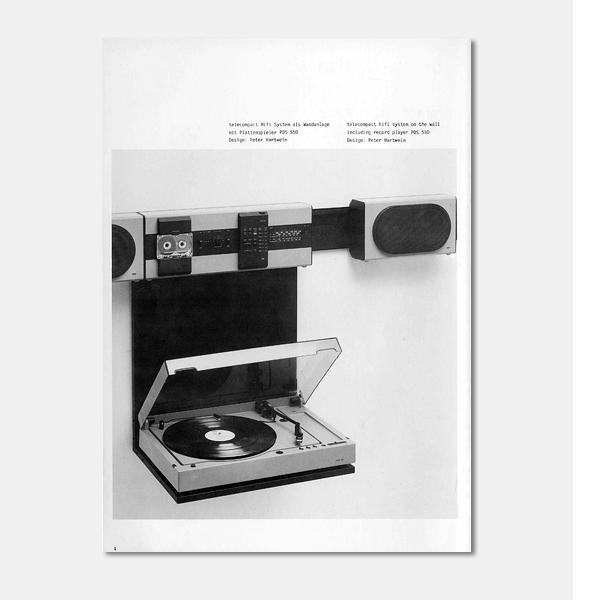
Jo Klatt
Electronic Braun Sets that never went of Produktion - Years of Development 1978/81
In this article, we are introducing four Braun sets which had been developed, successfully passed the marketing tests - and still did not go into production. Which is a pity, since the individual items bore particular technological and design features far advanced at their time; an important aspect from today's point of view.
telecompact Hifi-system
Braun statement: typical Braun 'niche' product of high user quality and optimal design, easy operation, favourably priced at approx. DM 1.500, --. The telecompact system was designed by Peter Hartwein. lt could simply be placed upright or tilted by aid of a curved metal support on the back. The system could also be hung up by means of a wall fastening device. Easy operation via IR remote control, which, could be incorporated into the system if not used.
Basic technical data: FM and medium wave bands, digital frequency and timer indication, IR remote control for receiver and cassette deck, loudspeaker output 2 x 25 W sin. The telecompact HiFi system could also have been a successful attempt to introduce to market a wall-hung set similar to Braun's legendary 1960ies ' model containing the TS 45 control system.
outdoor 2000
Braun statement: superior portable stereo radio recorder, intelligent design, price: DM 700,--; designer: Dieter Rams.
The outdoor 2000 had an uncommon, Braun non-typical asymmetrical design. In other words: it consisted of two housing parts put together by an elaborate specific mechanism; in operation the two parts could be pushed apart, thereby enlarging the distance between both loudspeakers and improving the stereo sound effect. The discongruous positioning of the loudspeakers further helped to improve the sound. This - on first sight - doubtful and uncommon asymmetrical Braun design now explains itself as logical and rather functional. The closed frame protected both operating keys and cassette deck, which had been fitted into the bottom part of the set. The outdoor 2000 set, an intelligent design fit to be the first of a totally new generation.
Basic technical data: FM, long, short and medium waves, digital frequency and timer indication, sensor keys, 2 x 10 W mains supply, 2 x 4 W battery operation, 12 V connection.
World receiver Braun travel 1000
Braun statement: small easy to handle travelling receiver of superior worldwide short wave reception. Every Braun enthusiast will think of the T 1000 when he reads the words world receiver. Yet, the Braun travel 1000 was to be marketed 25 years later. The small housing showed the astounding miniaturisation in electronics which had meanwhile taken place. Where in former times scale and indicators had been necessary, today one finds sensor keys and a CCD display for digital read-off.
This was the reason why Dieter Rams was able to design a relatively small device, not bigger than the palm of a hand. A curved metal support and a telescopic antenna (to be snapped to a handle when shoved together) were fitted on the back.
The calculated price was approx. DM 650, --.
Basic technical data: frequencies between FM 87,5 and 108 MHz, AM 150 KHz to 27 MHz. Station tuning, synthesizer with digital frequency LCD-display, output 1 W.
Braun Radio Alarm Clock
One of Dieter Rams designed radio alarm clocks was given little chances to be admitted to the 'chosen few'. In this product range countless manufacturers offered their sets at dumping prices. The Braun radio alarm clock would have been a 'niche' product for people who wanted to start the day by revelling in a beautiful Braun device and enjoying aethestically superior quality. This group of clients was too small for Braun.
Text: Jo Klatt
Photos: Braun AG
Source:
Klatt, J.: Electronic Braun sets that never went in Production. In Braun+Design 21, Hamburg 1991-1992, 4-9
